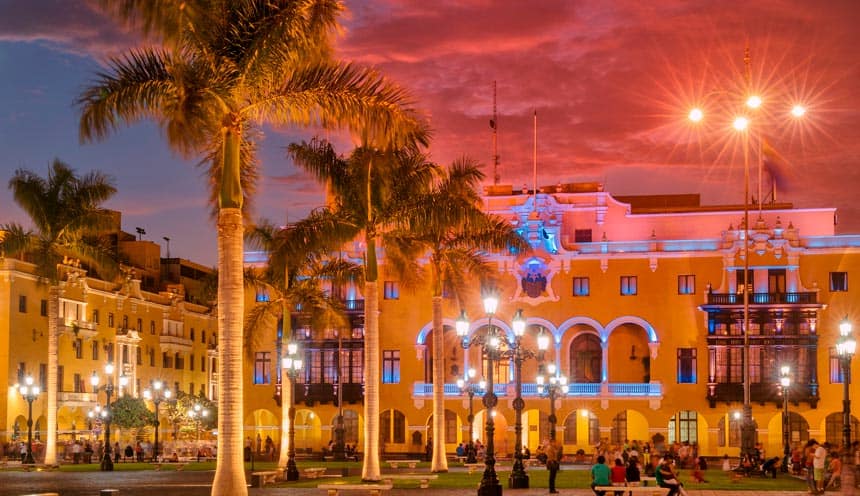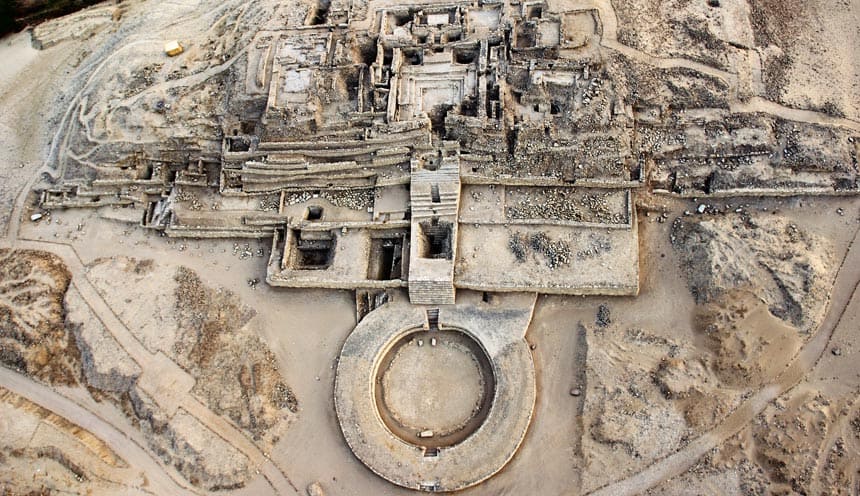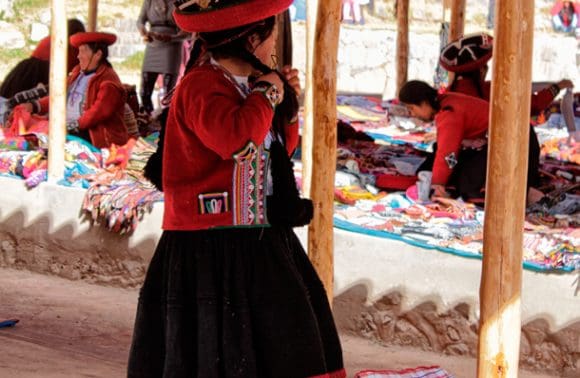Welcome to Lima!
Lima’s history predates the colonial presence in the country. The establishment of the viceroyalty transformed the city into the main political and administrative center of South America. During this period, significant churches, monasteries, mansions and balconies were built. he arrival of modernity didn’t transform the historic center, which is recognized as a World Heritage Site.
Museums with great works of art, archaeological sites, beaches, the boardwalk, valleys, natural reserves, the nightlife, the thrill of adventure sports, and the exquisite cuisine gives Peru’s capital an authentic personality and makes tourism in Lima a unique experience in the country.
Sights
Main Attractions in the city
Centre of the old colonial city. Around its edge are the Lima Cathedral, Government Palace and Provincial Municipal Authority of Lima. A highlight of the central part is a bronze fountain from the 17th century.
It occupies the site where the first major church in Lima once stood. It has an austere interior, although it is home to genuine historical treasures including the Baltasar Noguera choir stalls, several side altars and the remains of Francisco Pizarro. Tourists can also visit the Museum of Religious Art, which holds a significant collection of paintings, sculptures, chalices and chasubles.
Residence of Francisco Pizarro (1535), who built it on the ground previously occupied by Taulichusco, chief of the Rímac valley. Since then, the site has been the centre of political power in Peru. The building was rebuilt in the 1920s after a fire. It has many courtyards and halls dedicated to important figures in Peruvian history which have been carefully decorated with outstanding works of art. Daily, at 11:45, the Patio de Honor (Honour Courtyard) is the setting for the changing of the guard under the responsibility of the glorious Battalion of the Hussars of Junín.
A 17th-century archaeological complex. It includes the church, convent and plaza. The main façade of the temple was built using stone and features Corinthian columns. The façade boasts an open cornice with arches in which the Immaculate Conception is depicted. The cloisters area, decorated with tiles, houses the Museum of Vice-Royalty Art. The catacombs (subterranean galleries), which served as a cemetery during the colonial era, can also be visited.
Home to a restored fragment of the ancient wall that encircled Lima and which is believed to have been built in the 17th century to protect the city from pirates and attacks by enemies of the Spanish crown. The site contains the statue of the founder of Lima, Spanish conquistador Francisco Pizarro, as well as a museum exhibiting archaeological items discovered in the area.
Built in 1636, the church was inspired by the Jesuit mother church in Rome, with three naves. Unique in Lima due to its three entrances, a characteristic that is unique to cathedrals. It stands out due to its Churrigueresque altarpieces, and the space in the central naves feels full of paintings and tiles. Among the works of art that can be seen here, paintings from the Lima, Cusco and Quito schools are highlights, as are a series of golden carvings of some the founders of religious orders and a painting depicting the coronation of the Virgin by painter Bernardo Bitti.
Built with clay and adobe on the foundations of a pre-Hispanic building, its rooms had to be adapted due to an irregular layout over different levels. The main façade has a balcony built in the Republic era. Its courtyards are a highlight, the first decked in Italian marble from the 19th century and the second adorned with an old bronze fountain. The house has belonged to the same family from its construction in 1535 to the present day.
It is home to numerous artifacts, as well as rooms in which the Inquisition process took place. Among these is the Courtroom, where members of the Court of the Inquisition met. Interesting features include the “Secret Door”, which led to the private chambers of the Grand Inquisitor; the Torture Chamber; the area of the secret dungeons with underground cells; and the Inquisition Library. Toward the front, occupying the space where the Caridad (Charity) church and monastery (16th century) previously stood, is the Congressional Palace of the Republic, built in the neoclassical style between 1912 and 1916 and which holds an extensive library.
Miguel Mujica Gallo created this Museum to assist in the preservation of the history of pre-Columbian Peru and to display the gorgeous craftsmanship created through several centuries by the people of Peru. View over seven thousand pieces of hand-made contents, made from not only gold, but silver, platinum, and ceramic as well. Witness the beauty of the artistry that the Spanish encountered when they first came to Peru and become immersed in the country’s ancient history.
Here you will discover glorious fountains spread over an area of 8 hectares. Walk through the tranquil Tunnel Fountain of Surprises (Fuente Túnel de las Sorpresas) or witness the awesome power of the Magic Fountain (Fuente Mágica) which can shoot water up to heights of 80m (260ft)! Be sure to see, and hear, the Fantasia Fountain (Fuente de la Fantasia) that is synchronized to music and subject to a regular laser show!
This marvelous museum exhibits artwork from a range of 10,000 years of Peruvian pre-Columbian history. Famous for its vast collection of erotic ceramics and pottery, it also contains a great selection of pieces that have survived since the 16th century Spanish conquest. Gain a greater understanding and appreciation of Peru’s fascinating roots by exploring everything this museum has to offer.
Main Attractions beyond the city
A traditional manor house, whose owners have been involved in breeding Peruvian Paso horses for years. Twice a week they put on a show in which visitors can see the delights of these unique animals, accompanied by a dinner of regional food and a folkloric show.
One of the last valleys of Lima. Visitors can take a tour through the Plaza de Armas and the Pisco Museum, followed by a walk through the Green Ravine and an eco-tourism tour through the Lúcumo Hills. Visitors can also see the Piedra del Amor (Love Stone) in the Cardal (a rock formation similar to a couple sitting down and embracing), as well as paragliding from the Punta Blanca Hill. An ideal setting for open-air sports.
The most important commercial centre on the Peruvian coast since pre-Inca times. The site holds palaces, plazas and temples built with mud (some of which have been restored), among which the Temple of the Sun and the Acllahuasi are highlights. Both were built during the Inca era (1440-1533), in the best preserved sector. There is a site museum with items discovered during excavations.
This is a very fertile land where orchards and vineyards stretch along both sides of the Cañete River. Perfect for adventure sports or open-air activities, including rafting, mountain biking and hiking. It offers a varied cuisine, as well as delicious pisco and regional wines. In its surroundings, the Incahuasi archaeological site can be found, which dates back to the middle of the 15th century. The site has beautiful hanging bridges, temples and towns that can be toured on horseback.
The Caral Sacred City has been declared a UNESCO World Heritage Site. The site corresponds to the most ancient civilization in Peru and the Americas (5,000 years old). Together with Mesopotamia, Egypt, India, China and Mesoamerica, it is one of the cultures that allowed States, cities and great civilizations to flourish. Plazas at the foot of imposing pyramid constructions have been discovered. This is where inhabitants met to worship gods and exchange products, under the gaze of political and religious authorities.







Leave a Review